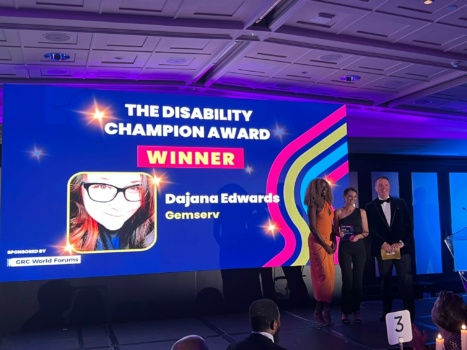Dajana Edwards, Technical BA at Gemserv, was named Disability Champion of the year at the GRC World Forums’ Diversity, Equity and Inclusion in Tech Awards.
To mark Disability Pride Month, Dajana explains why invisible disabilities are often overlooked and how your organisation can take steps to be more inclusive.
When you picture a disabled person, you may immediately see a wheelchair user, or someone walking with a cane or a guide-dog. However, disabilities can take many different forms and current estimates are that only 20% of the 1 in 5 disabled people in the UK present ‘visible’ disabilities.
What is an invisible disability?
It sounds obvious, but an invisible disability is one that we can’t see or isn’t immediately obvious. InvisibleDisabilities.org describes them as “a physical, mental or neurological condition that is not visible from the outside, yet can limit or challenge a person’s movements, senses or activities.”
These can include:
- mental health conditions,
- visual and hearing impairments,
- bladder and bowel disorders,
- chronic and often energy limiting conditions,
- cognitive and sensory impairments,
- learning disabilities.
What are the impacts of an invisible disability?
An often-unknown aspect of having an invisible disability can be the battle against misunderstanding, misconception and misinformation. These can come many forms, but there are three key areas where they can feel most affected.
Barriers to support and understanding
A person with an invisible disability may ‘look well’ on the outside. However, they may live with debilitating symptoms which impact every aspect of their personal and working lives. Due to the less visible nature of their disabilities, they often struggle to be believed by health and government professionals, as well as friends, family, and colleagues. As a result, they can face barriers in accessing the support, resources and accommodations that they need.
Fluctuating severity
Invisible disabilities can be dynamic, meaning that they fluctuate in severity. One day you might see someone use a crutch or wheelchair, and the next day walk unaided. This can be difficult for some people to understand. They may even be tempted to question the validity of the disability (“how come you can walk ‘fine’ today, but not yesterday?”)
Suffering privately
There is a worry from those who have invisible disabilities that others may not believe them. Negative past experiences and perceived bias around disability could lead choosing not to disclose them to friends or at work. Feeling safe enough to effectively communicate your needs, access requirements and boundaries can be empowering, rewarding and beneficial.
How to support employees with invisible disabilities
Accessibility from the top
- Embed accessibility into the bones of your company. Start with inclusive policies and a fully accessible recruitment process.
- Champion yourself as a disability friendly employer who is adaptable and flexible.
- Review your working environment to benefit all staff. This includes putting measures in place to help with sensory overload, re-thinking hot desking and ensuring that your hybrid meetings and face-to-face events are accessible.
Take the time to educate yourself
- Educate yourself on disabilities and be mindful that someone you are working with may be going through things that you have no idea of.
- If a colleague discloses their invisible disability with you, believe them. You may not be able to see the disability, but the symptoms are no less real. Take the time to educate yourself on their conditions(s) and ask how you can support them.
Provide and attend disability awareness training
- Educate staff. Provide disability awareness training, and information on common invisible disabilities, possible symptoms and how they might manifest in the working environment.
- Raise awareness and empathy by looking at examples of what a typical day for employees with invisible disabilities can look like and what barriers they might face.
Consider accessibility in all you do
When you host a virtual or in person meeting, do you think about accessibility? Do you ensure that:
- Breaks are factored into your meeting agenda?
- Venues are fully accessible?
- Your Power Point and documentation are accessible?
- Your social media content is accessible?
- You share materials in advance?
- You tell attendees that they can switch off cameras if they prefer to do so?
- You ask about any access needs?
If not, this is a great place to start.
Collaboration and teamwork
- Be adaptable when working with others who may need flexibility to manage their health. They may require a working day that looks different to yours, cameras off on video calls, or email-only communication. Appreciate the individual ways that people work and the flexibility that exists in the workplace.
- Make use of buddy systems in a way that is helpful to those of us who live with invisible disabilities and help us to harness our brains and ways of working in positive ways.
- Be inclusive. Make use of technology to include team members who are WFH in social events and consider other ways that you can include people who cannot physically attend Christmas parties and other in person events.
The important thing to note is that it is not a ‘one size fits all’ situation as different people have different needs, if someone discloses to you, the best option is to ask them what they need. Listen to and learn from disabled voices.



